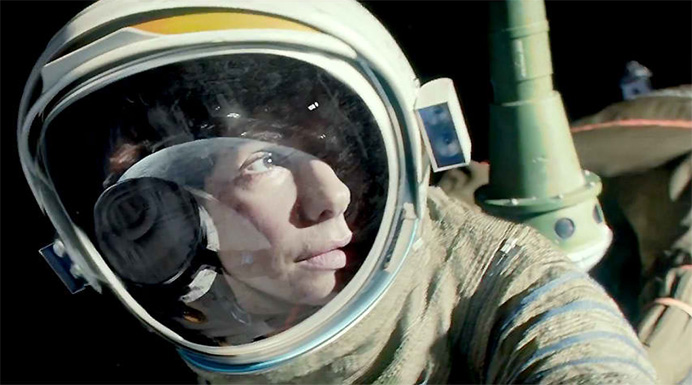
Gravity (2013)
Directed by Alfonso Cuarón
Written by Alfonso Cuarón & Jonás Cuarón
90 min.
The following is a rebuttal to a recent Smug Film review, ‘Gravity: A Lifetime Movie in Space‘. Mild spoilers.
Gotta disagree on all counts.
Let’s go through it. The 3D diorama effect was kind of essential here, because it’s a film in a setting where people are literally thin slices floating on a plane of nothingness. It created strong contrasts between Bullock and the stars, debris and earth, and even the thumb-printed glass of the helmet and the actor’s faces. There’s one moment where a space station, a person, and the Earth are all in frame, separated by hundreds of miles, and all perfectly in focus because of a lack of atmospheric distortion. The 3D made that distance come alive in a way it can’t in 2D. It’s about gulfs, impossible blank gulfs, and that’s why it’s one of the only truly essential uses of 3D I’ve seen yet. About the only other one I can think of is Cave of Forgotten Dreams, which used it to bring out distances of millimeters of depth on a wall. Seems like 3D is at its best when it’s working with the very small or the very large.
Bullock is in space because she’s a specialist fixing a special part! It’s a MacGuffin, sure, but not implausible by any stretch. Don’t forget, one astronaut once strapped on a diaper and drove cross country to kidnap her lover. There’s a rumor there was a labor strike on Skylab. We still don’t know if Gus Grissom panicked and popped the emergency hatch on Liberty Bell 7 early. Astronauts are human beings, come on. High stress in space is something NASA accounts for but it can’t be predicted 100% or controlled. People are people even in space. Besides, it’s irrelevant. She’s good enough to do her job properly and efficiently. Her fear is a Hitchcockian heightening of the tension. I don’t just throw Hitchcock out there idly; it reminds me a lot of Grace Kelly’s mounting, isolating desperation in Dial M for Murder.
I totally agree with your characterization of Clooney as “brash and headstrong and smarmy as the day is long, almost to the point of self parody,” and I think it’s actually why he works as a foil to her. He prods her into living. That’s the wisdom he gives her to apply to her universe (“respective universes,” I’m going to steal that phrase)—that life has to be lived. He has faith in life, sublimated in his quasi-religious prayers to “Houston in the blind.” On the other hand, the content of his stories is actually pretty sad, as unmoored as he is on his jet pack. Her subdued—oh god I can’t think of a better word—depth offers him some stability. It’s nice that we meet them with her unsteadily glued in space and him flitting around unpredictably.
As for tentacle rape? Bro, I think that’s something you’re bringing to the movie, not something the movie’s bringing to you. The cords are clearly and consistently coded as umbilical symbols. That’s why she’s half-naked; it’s birth imagery. Get your head out of tentacle sex! Besides, it’s customary and right to have your hero in a stripped down survival film as naked as possible. It highlights human frailty, vulnerability, and makes the danger seem even more intense. This is something they’ve been doing since Cornel Wilde in The Naked Prey, a major touchstone for this film. It’s why Ripley stripped for the last act of Alien; there’s a palpable tension in the air when bare flesh is in danger. It also enhances the contrast between our human selves and the heavy, clunky, ungainly equipment we depend on to live. The way that equipment turns against us is central to the film—see again those treacherous cords everywhere and see the way at the film’s end she needs to remove the suit to live.
I don’t know what to tell you about the visuals other than they’re perfect. Absolutely gut-punch perfect. They work thematically, of course. The constant sense of unspooling and escalating disaster is inflated by the careening and relentlessly long takes. The thing about Gravity is that the plot isn’t separable from the visuals. Like the way the camerawork in the end of Goodfellas told us the state Henry was in without having to come out and ever say ‘coked out of his mind’, the camerawork in Gravity works to tell the story. We watch a woman’s progress out of her shell (that stripping out of a spacesuit image again!) into the world she fled for space. We don’t hear it, it’s not recounted to us with narration. We see it happen. There are no aesthetics for its own sake, we have images of increasingly primal iconography and the literal disintegration of distancing technology to tell the story of a woman who inevitably, inexorably (like gravity!) must return to the world around her. It’s stunningly, unimpeachably, perfectly cinematic.
The sound thing—do you have the same complaint about 2001, which also contrasts the stone silence of space with a heavy, present score? Feels like a complaint for the sake of complaining, bro.
Anyway, Gravity is my pick for the film of the year so far. It’s dynamite visual storytelling, as innovative as Abel Gance and, like the best films, unafraid to dive into metaphorical, metaphysical filmmaking. It feeds a hunger I’ve had for a long time: the hunger for a smart and beautiful film which uses every tool of 21st century filmmaking.
5 out of 5.
One thought on “A Rebuttal to ‘Gravity: A Lifetime Movie in Space’”